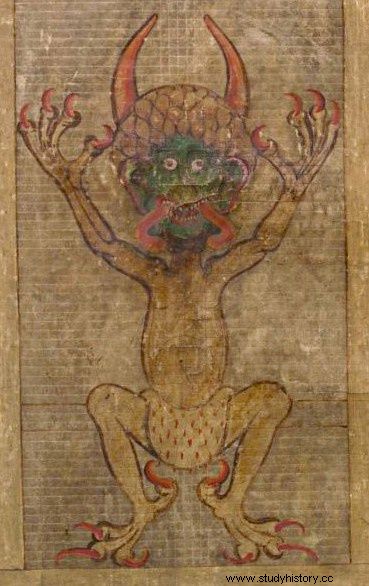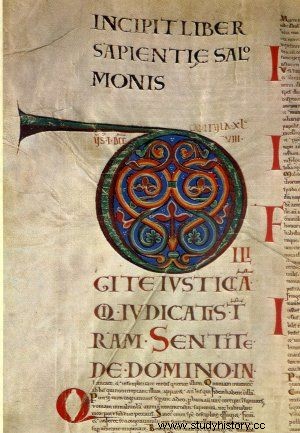In world history - especially when we study archives preserved in the darkness of the Middle Ages - legends are an invaluable source of knowledge. And inspiration. After all, thanks to our imagination, we are able to add new chapters to the chronicles of civilization ... and sometimes even entire books. The proof is the Codex Gigas, probably the largest existing manuscript in which the image of the devil himself was depicted. However, the manuscript is not a fantasy, but a real man-made work.
The mysterious manuscript was written in the Benedictine monastery in Podlažice, near the town of Chrudim. The order is associated with a place sanctified by religion. But even in the realm of the sacred, there is sin. The representatives of the order also had to face forbidden desires . Of particular interest is the case of one of the brothers we know about from an ancient legend. And yet in them you can find a grain of truth ...
Satan inspired monk
According to the folk legend, the author of the sacred text was a monk who broke the monastic rule. There must have been a tremendous sin on his conscience, for his superiors had no doubts that the punishment should be the highest. Walled alive in a cell - this is the price for such offenses. The monk, however, decided to beg for the possibility of penance. The condition was simple. On the night before the execution, the monk was to write down a religious work that would make the monastery famous. Backbreaking task, practically impossible. Still worth the risk.
The condemned man, being in the darkest hour of his trial, decided that he would ask the fallen angel for help in developing the work . The hand of the mortal was therefore guided, not by God, but by Satan. And it is his image that appears on the page of a particular version of the Bible.

The drawing of the devil on page 290. Legend has it that this manuscript was created by a monk who sold his soul to the devil
Divine greatness, devilish secrets
The name of the manuscript is meaningful. Because "Codex Gigas" is otherwise the "Great Code" or "Big Book". The engraving showing the face of the demon is true and it is because of it that the manuscript is sometimes called the "Devil's Bible". It is not hard to guess that no other copy of the Bible has such an image. It is also special, because the graphic work shows us Lucifer locked in a prison, a chamber of evil.
The format and size of the manuscript arouse genuine admiration. The codex, which is now stored in the Royal Library in Stockholm, measures nearly a meter in height. Half a meter wide, more than 20 centimeters thick, weighs 75 kilograms. Probably the largest manuscript in history, more than 300 vellum cards were used, for which skins from about 160 animals were used. Numbers can make an impression. No wonder the manuscript has been equated over the centuries to one of the Seven Wonders of the World and is sometimes referred to as the Eighth Wonder. It impressed with its form. And also the content.

The manuscript is very rich in illuminations
The complete text includes not only the text of the Old and New Testaments, but also the encyclopedia "Etymologiae" by Izdyor of Seville, a Spanish archbishop, and the "Chronicle of the Czechs" by Cosmas of Prague, who is considered to be the first Czech chronicler.
The most interesting, however, was recorded in subsequent parts of the manuscript. Mysterious medical treatises, folk parables, and truly devilish secrets - magical formulas that were supposed to be used for exorcisms . The manuscript contains illuminations in the following colors:red, blue, yellow, green and gold. And all in one volume written by one man. Is it possible? Is there really a grain of truth in the legend?
Historical Investigation of a Religious Cause
Determining the authenticity of a document involves in-depth research. The entry in the book seems to indicate that the probable date of completion of work on the Devil's Bible was 1230. Representatives of an international group of modern experts - made up of palaeographers, librarians and biblical scholars - found that one man, if he had worked without any major interruptions, could have written a carefully written page. in about an hour. Working on thousands of pages of the Gigas Codex would mean about twenty years of real sacrifice . In silence. Seclusion. Real loners that could be a kind of penance.

The Codex Gigas impresses with its size
The word inclusus has frequently appeared in the demonic legend of the sinful mortal throughout the ages. Graphologists discovered that the Latin word, which means not so much (and - not only) punishment, but isolation, has been misinterpreted and interpreted. Benedictine patience has been paid back. Inclusus here most likely means not the punishment of being walled up alive, but a monk who voluntarily isolated himself from the world after living in an isolated cell. This is also known from the analysis of the ink, which was the chemical signature. Made of a variety of metals and crushed insect nests, it leaves no doubt that the "Bible of Satan" was in fact compiled by only one mortal.
The original project - extremely impressive both in form and content - can therefore be attributed not to a group of Czech monks, but to one, in addition, a very specific person. Researchers were even able to identify the name of the author of "Codex Gigas". Hermanus Monachus Inclusus, a monk inspired by Satan, or rather a monk guided by the will of divine enlightenment? The duality of human nature - good and evil - finds expression in the manuscript itself . Because on the page before the picture of Satan there is an impressive drawing of the kingdom of heaven ...
